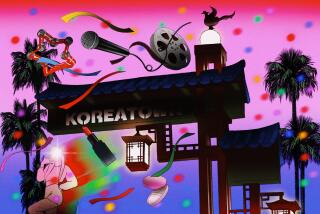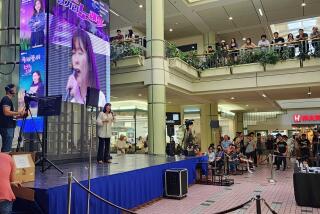MUSIC REVIEWS : ‘The Sound of Millennia’: A Potent Sampler of Korea
- Share via
The breath, we are told, is the basis of rhythm in Korean music. Easy to believe, after seeing 15 dancers floating behind Lee Jun-Ah singing “Isudaeyop,” the corps reflecting her phrasing in the spatial embodiment of respiratory expansion.
The tension and release of the breath cycle infused “The Sound of Millennia,” Saturday in Shrine Auditorium, with an exuberant serenity at all levels, from the elastic meter of individual phrases to the pacing and organic logic of the whole show.
Presented by Sorii-pae--a gathering of 136 South Korean performers touring in celebration of that country’s admission to the United Nations--the vivid program made a virtue of anthology expediency by converting the often severely truncated samples into a sort of mega-drama.
Part I--the inhalation on the macro level--presented mostly court-based musics. At the core of the section was that miraculously sustained lyric song “Isudaeyop,” with its liquid dance mirror, and an equally astonishing translation of sound into sight by salpuri dancer Hong Keum-San and taegum flutist Soh Yong-Sok.
In a ceremonial court setting, intimacy became austerity and simplicity became solemnity. The National Classic Music Orchestra offered the spare, intensely concentrated “Chonpae Huimun,” from the Chongmyo shrine.
Framing Part I was the sound of the kayagum, a zither plucked with a seemingly infinite variety of articulation. That was about all Hwang Byung-Ki had time to demonstrate in his condensed sanjo solo, but his “Chimhyangmu” (Dance in the Fragrance of Aloes) for an orchestra of 40 kayagums proved a dynamic performance vehicle, merging traditional and contemporary elements.
The energy built up through the first half was released in joyful gusts after intermission, as the drum replaced the kayagum as the dominant instrument. Forty thunderous drums of all shapes and sizes were employed in “May Every Day Be Like Today,” an amazing controlled riot of sound and color choreographed by Kook Soo-Ho.
Distilled into a sort of folk chamber music, the vitality of the drumming became pure pulse power in the playful samul-nori exchanges of the Kim Duk-Soo Troupe.
Two excerpts from the pansori repertory showed some of the range of this form of people’s opera. Without supertitles or program translations, a narrative duet scene was left largely incomprehensible to non-Korean speakers, but both the musical and physical imagery of a rowing song from “Shimchongga” quickly bridged linguistic and cultural gaps.
The program proper ended with an enigmatic ode to entertainers from Kim Jung-Ok’s “Flowering in a Windstorm,” a poignant masked merger of traditional and modern theater. Then the whole company assembled for bows, which dissolved into an encore frenzy of dancing drums.
Production values were high throughout, with swift, smooth scene changes. The same could not be said on the other side of the proscenium, where a video camera blocked views of the stage center, and the audience filtered in up to intermission, due in large measure to the horrific parking situation, something not mitigated by a well-mannered demonstration protesting the U.N. acceptance of a divided Korea.
More to Read
The biggest entertainment stories
Get our big stories about Hollywood, film, television, music, arts, culture and more right in your inbox as soon as they publish.
You may occasionally receive promotional content from the Los Angeles Times.










